|
חגים יהודיים
ha-gim ye-hoo-di-yim Jewish Holidays The Jewish calendar is a lunar calendar.
All Jewish holidays begin at sundown of the night before.
The Jewish years are counted from creation.
In the list of holidays, "BCE" stands for "Before Common Era" and "CE" refers to "Common Era" on the Gregorian (Civil) calendar.
All Jewish holidays including Jewish crafts and recipes are taught in our
free Hebrew Podcasts newsletter.
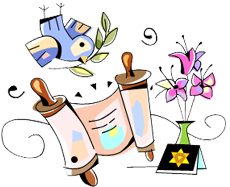 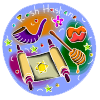 Rosh Hashanah, Head of the Year, is celebrated on Tishrei 1-2 (Sep-Oct). The Jewish New Year celebrates the beginning of ten days of repentance before Yom Kippur which is the Day of Atonement on Tishrei 10.
At the synagogue, the shofar (a trumpet made from a ram's horn) is blown. Traditional foods are challah, apples dipped in honey to symbolize the coming sweet year, fish heads to symbolize success (to be at the head and not at the tail) and pomegranates that symbolize fertility because of their many seeds. Greeting cards for the New Year (H: Shana Tova) are sent to friend and family.
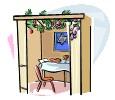 Sukkot, Huts, is celebrated on Tishrei 15 (Sep-Oct) and marks the temporary settlements of Jewish people in the desert after the exodus from Egypt in 1313 BCE.
The Sukkah is a temporary dwelling where the family eats the meals with guests. The Sukkah has to be at least partly under the sky and its cover has to be under the open sky. The cover of the Sukkah has to be organic and is usually made from palm leaves. The children decorate the Sukkah with pictures and paper chains.
Another tradition is to show and include the Four Species of plants during the meal. These species are: the Lulav (date palm frond), Hadass (bough of a myrtle tree), Aravah (willow branch) and the Etrog (a citron, a lemon-like citrus fruit).
Simchat Torah (the joy of the Torah) - Tishrei 23 - follows immediately after Sukkot, and is an especially festive day in which the very last portion of the Torah is read in the synagogue. The children dance around the Torah with flags in their hands.
 Hanukkah, Dedication, is celebrated on Kislev 25 (Nov-Dec) and marks the Macabees victory over Antiochus the Greek king and the rededication of the Temple in Jerusalem in 165 BCE (3597). Oil was found in the temple, but it was only enough to light the Menorah for one night. Miraculously, it lit the Menorah for eight nights. To celebrate this miracle, on each of the eight nights, another candle is lit in the Hanukiah (a special Menorah with 9 candle holders) and special songs are sung. The traditional foods are fried foods such as latkes (potato pancakes) and sufganiyot (jelly doughnuts). Kids love playing the dreidel (spinning top), and parents give them Hanukkah gelt (Yiddish for money, a chocolate coin).
The dreidel, which is called Sevivon in Hebrew, is a four-sided spinning top with 4 Hebrew letters that are the acronym of the sentence Nes (miracle) Gadol (big) Haya (was) Po (here). Kids who play outside of Israel have dreidels that have the letters for the sentence Nes (miracle) Gadol (big) Haya (was) Sham (there).
 Tu Bishvat is celebrated on the 15th of Shevat (Jan-Feb) and marks the New Year for Trees.
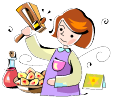 Purim, Lots, for lottery performed by Haman is celebrated on Adar 14 (Mar-Apr) and marks the cancellation of the decree against the Jewish people by Haman in ancient Persia in 425 BCE. After the destruction of Judah, the Jews were taken into the seventy-year Babylonian captivity. The Book of Esther (H: Megillat Esther) tells the story of King Ahasuerus (H: Achashverosh) of Persia who organized a feast in Shushan to celebrate Queen Vashti’s beauty. She refused his command and he dethroned her. Ahasuerus chose Esther as his new wife. He was saved by Mordechai, Esther’s Jewish cousin, who revealed the conspiracy by Bigthan and Teresh (two royal guards) to assassinate the king. Haman (the royal advisor) vowed to exterminate all the Jews after Mordechai didn’t obey him. Ester intervened and the Jews were saved.
Traditions of Purim include reading the Megillah (H Scroll) and making a lot of noise with a noisemaker (H: ra'ashan) when Haman's name is mentioned.
Giving Mishloah Manot (parcel of food portions) to poor people, family and friends. Homemade hamantashen (H: Oznei Haman- Haman’s ears), or triangular pastries, are eaten. Kids love to dress up in costumes and masks and parade with them.
 Pesach, Passed over, is celebrated on Nisan 15 (Mar-Apr) and marks the exodus of the Jewish people from ancient Egypt in 1313 BCE. The Jews painted blood on their doorway and their houses were saved from the plagues. They fled Egypt on a short notice and did not have time to let their bread rise. The Matzo (H: Matzah), an unleavened bread, is the symbol of Passover and is eaten instead of bread. Spring cleaning in the Jewish houses has an added dimension of ridding the house of any Chametz. "Kosher for Pesach" means that the foods are fit to be eaten during Passover, usually using potato starch or matzo meal instead of flour. During Passover it is forbidden to eat and have at home any type of grains such as wheat, rye, barley or oats. These items are called Chametz.
The main tradition is the Seder (order) Meal and reading the Haggadah. The Haggadah is the story and songs depicting the Exodus from Egypt while following holiday rituals. The Afikoman is a special treat for the kids. It is a piece of matzo that is being hidden during the Seder and the child who finds it gets a treat.
The Seder Plate:
Fresh greens - A symbol of springtime and rebirth
Roasted hard-boiled egg - a reminder of ancient festival offerings in Jerusalem
Roasted lamb shank - representing the lamb sacrificed at the first Passover
Charoset - Symbol for the mortar used by Jewish slaves to build the Egyptian temples
Horseradish - A reminder of the bitterness of slavery
Bitter herbs (usually lettuce) - A reminder of the bitterness of slavery
 Yom Ha'atzmaut, Israel Independence day is celebrated on Iyar 5 (Apr-May) and marks the declaration of the state of Israel in 1948. Yom Ha'zikaron precedes Yom Ha'atsmaut by one day. It is the Remembrance Day on Iyar 4 for all the fallen soldiers of the Israeli army (more than 22,000) and victims of terrorism (more than 1,600). On Yom Ha'atzmaut there is a tradition to have a picnic and barbeque in the parks and forests. In the evening, people celebrate in the streets with songs and dances, and balconies are decorated with Israeli flags. The design of the Israeli Flag is a blue Star of David (H: Magen David) in the middle between two blue horizontal lines on a white background. The blue represents the color of the sky. The star represents a shield that protects King David. The white represents purity.
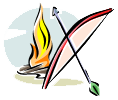 Lag Ba'omer, 33rd day of the Omer is celebrated on Iyar 18 (May-Jun) and marks a break in the mourning period for the 24,000 students of Rabbi Akiva who died, some by plague and some in the rebellion against the Roman Empire in 120 CE.
 Shavuot, Weeks, is celebrated on Sivan 6 (May-Jun) and marks bringing the first harvest to the Temple to remember the giving of the Torah and the Ten Commandments 7 weeks after the Exodus from Egypt at Mount Sinai in 1312 BCE (2449). Shavuot is the Festival of Reaping of the first fruits of the harvest (Bikurim).
Kids parade with flowers in their hair, wearing white clothes and carrying decorated baskets full of fruits.
Dairy products such as milk and cheese are served at the traditional holiday meal.
|